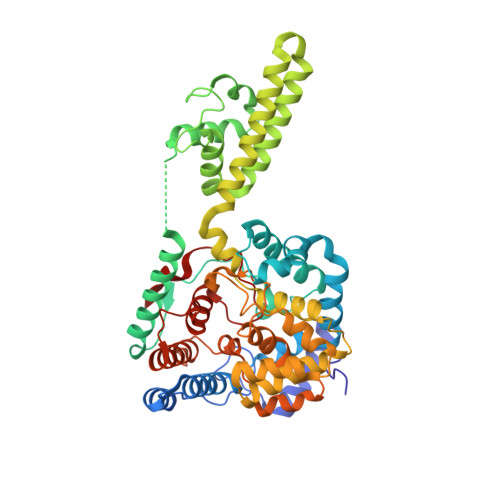Structure, Function, and Evolution of the Crimean-Congo Hemorrhagic Fever Virus Nucleocapsid Protein.
Carter, S.D., Surtees, R., Walter, C.T., Ariza, A., Bergeron, E., Nichol, S.T., Hiscox, J.A., Edwards, T.A., Barr, J.N.(2012) J Virol 86: 10914
- PubMed: 22875964
- DOI: https://doi.org/10.1128/JVI.01555-12
- Primary Citation of Related Structures:
4AKL - PubMed Abstract:
Crimean-Congo hemorrhagic fever virus (CCHFV) is an emerging tick-borne virus of the Bunyaviridae family that is responsible for a fatal human disease for which preventative or therapeutic measures do not exist. We solved the crystal structure of the CCHFV strain Baghdad-12 nucleocapsid protein (N), a potential therapeutic target, at a resolution of 2.1 Å. N comprises a large globular domain composed of both N- and C-terminal sequences, likely involved in RNA binding, and a protruding arm domain with a conserved DEVD caspase-3 cleavage site at its apex. Alignment of our structure with that of the recently reported N protein from strain YL04057 shows a close correspondence of all folds but significant transposition of the arm through a rotation of 180 degrees and a translation of 40 Å. These observations suggest a structural flexibility that may provide the basis for switching between alternative N protein conformations during important functions such as RNA binding and oligomerization. Our structure reveals surfaces likely involved in RNA binding and oligomerization, and functionally critical residues within these domains were identified using a minigenome system able to recapitulate CCHFV-specific RNA synthesis in cells. Caspase-3 cleaves the polypeptide chain at the exposed DEVD motif; however, the cleaved N protein remains an intact unit, likely due to the intimate association of N- and C-terminal fragments in the globular domain. Structural alignment with existing N proteins reveals that the closest CCHFV relative is not another bunyavirus but the arenavirus Lassa virus instead, suggesting that current segmented negative-strand RNA virus taxonomy may need revision.
Organizational Affiliation:
Astbury Centre for Structural Molecular Biology and the Institute for Molecular and Cellular Biology, University of Leeds, Leeds, United Kingdom.















